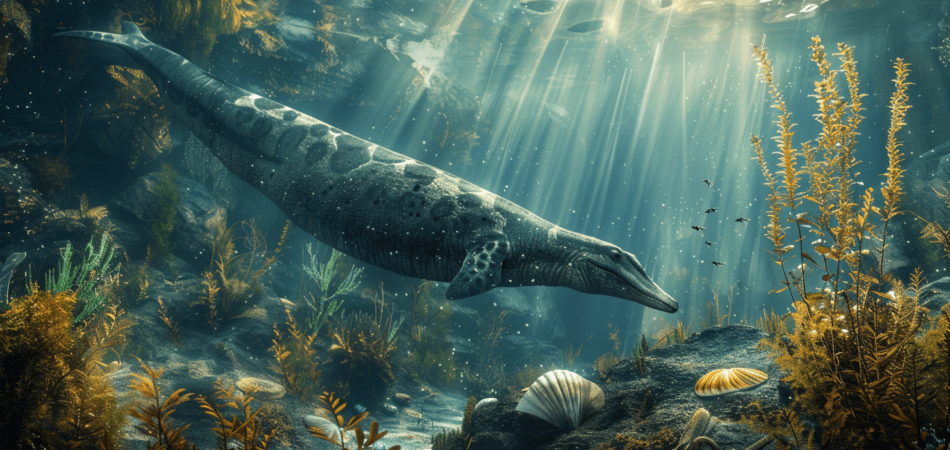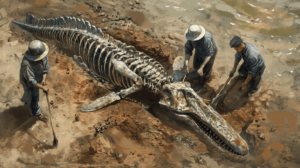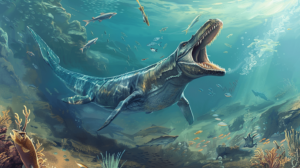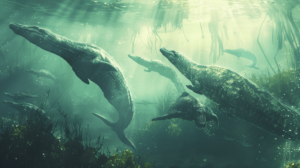Aardonyx Guide:
Aardonyx was an early dinosaur that lived in South Africa about 200 million years ago.
Aardonyx was an early dinosaur that lived in South Africa about 200 million years ago.

Plesiosaurs, ancient marine reptiles, thrived from the Late Triassic to the Late Cretaceous periods. You’ll find Mary Anning’s 1823 discovery fascinating, alongside contributions from figures like Richard Verstegen and Edward Lhuyd. These creatures evolved into two main groups: long-necked plesiosauromorphs and large-headed pliosauromorphs, adapting to diverse marine environments worldwide. They fed on fish and cephalopods, using their long necks and sharp teeth. Evidence suggests plesiosaurs gave birth to live young. Sites like Lyme Regis in England and the Queensland Museum in Australia hold significant fossils. If you’re curious, there’s much more to uncover about their intriguing lives.
Historically, significant plesiosaur discoveries, often shaping our understanding of these ancient reptiles, were made by pioneers like Mary Anning, who uncovered an almost complete skeleton in 1823. You might find it fascinating that before Anning’s groundbreaking find, figures such as Richard Verstegen, Edward Lhuyd, and William Stukeley laid the groundwork for plesiosaur research in the 17th to 19th centuries. Their efforts, although less celebrated, contributed immensely to the field of paleontology, setting the stage for later discoveries.
You’re probably aware that plesiosaurs thrived from the Late Triassic to Late Cretaceous periods. This era marked a significant phase in plesiosaur evolution, where they diversified into two main forms: the long-necked plesiosauromorphs and the large-headed pliosauromorphs. These classifications reflect adaptations that allowed plesiosaurs to dominate marine environments during their reign.
Mary Anning’s discovery in the cliffs of Lyme Regis didn’t just highlight the existence of these creatures; it opened a window into the complex life these marine reptiles led. Her find, an almost complete skeleton, was pivotal in illustrating the diversity within the plesiosaur lineage.
As you dig deeper into the history of plesiosaur discoveries, it’s essential to appreciate how each find, from Anning’s detailed skeletons to the initial fragments identified by Verstegen, Lhuyd, and Stukeley, has pieced together the puzzle of plesiosaur evolution. These pioneers didn’t just unearth bones; they disclosed a chapter of Earth’s history, allowing us to glimpse into a world where these majestic creatures ruled the seas.

Mary Anning’s groundbreaking 1823 discovery of an almost complete plesiosaur skeleton marked a pivotal early milestone in the field of plesiosaur paleontology. This find not only captured the imagination of the scientific community but also laid the groundwork for future plesiosaur discoveries. Since then, the quest for understanding these ancient marine reptiles has unearthed a wealth of fossil remains, enriching our knowledge of their existence.
You’ve likely heard of the Monster of Aramberri, a remarkable find that stands out among recent plesiosaur discoveries. This, along with an intact juvenile plesiosaur in the UK and several new species identified across the globe, has significantly expanded our understanding of plesiosaur behavior and evolution. These discoveries aren’t just isolated incidents; they’re part of a broader trend that has seen about half of the known plesiosaur species being identified in recent decades.
Modern research methodologies, particularly cladistics, have played a pivotal role in these advancements. By analyzing the global plesiosaur fossils, scientists have been able to piece together a more all-encompassing picture of these creatures’ lives, from their hunting techniques to their swimming adaptations.
The plesiosaur skeleton, whether it’s a new species or a well-preserved specimen, continues to be a source of fascination and insight. Each find adds another piece to the puzzle, helping us to appreciate the diversity and complexity of life that existed millions of years ago. So, next time you hear about a plesiosaur discovery, remember that it’s not just a relic of the past but a key to understanding our planet’s rich natural history.
Building on our understanding from recent discoveries, let’s explore how plesiosaurs evolved, revealing two distinct lineages with unique adaptations for life in ancient seas. The evolution of these marine reptiles branched into pliosaurs, featuring short necks and elongated heads, and plesiosauroids, with their small heads and snakelike necks. This divergence highlights a fascinating aspect of plesiosaur evolution, emphasizing the variety of life forms adapting to different niches in the marine environment.
As time progressed, both lineages exhibited a noticeable size increase. Take, for instance, the Elasmosaurus, with its astonishing 76 neck vertebrae, stretching up to 13 meters in length. Similarly, the giant pliosaur, Pliosaurus funkei (Predator X), boasted an estimated length of 15 meters and a bite force of 33,000 pounds per square inch, showcasing the formidable presence these creatures had in ancient seas.
The anatomical features of plesiosaurs, such as the long necks and flexible bodies of plesiosauroids and the shorter necks and elongated heads of pliosaurs, played a significant role in their feeding behavior. Plesiosaurs likely mastered underwater flight, propelling themselves with powerful flippers in a manner akin to modern sea turtles. This unique mode of locomotion enabled them to ambush fish schools, swinging their heads to capture prey with sharp teeth and their long, flexible necks. It’s these evolutionary adaptations that underscored their success in prehistoric marine ecosystems, allowing them to thrive and diversify into the awe-inspiring species we’re still uncovering today.
Delving into the anatomy and skeleton of plesiosaurs reveals a sophisticated design tailored for life in ancient oceans, with a unique combination of features that supported their aquatic lifestyle. These marine reptiles, which roamed the seas during the Mesozoic era, displayed an array of physical characteristics that distinguished them from other prehistoric creatures.
Imagine these distinct features:
Through these features, plesiosaurs were perfectly adapted to their aquatic lifestyle, showcasing a remarkable example of evolutionary design among marine reptiles.

Having explored the unique anatomy and skeletal structure of plesiosaurs, let’s now examine how these features played a pivotal role in their diet and hunting methods. You’ll find that their long necks weren’t just for show; they were integral to their survival in the ancient seas.
Plesiosaurs mainly feasted on fish, cephalopods, and other marine organisms. Their long, flexible necks allowed them to surprise prey, while their sharp teeth were perfect for grasping and slicing through flesh. Imagine a plesiosaur, its head darting through the water with agility, swinging its head through schools of fish, catching them off guard. This wasn’t just a simple chase; it was a well-orchestrated ambush where agility and precision were key.
Their specialized teeth were not just sharp but adapted specifically for their diet, ensuring that once prey was caught, it was not easily lost. Here’s a closer look at the connection between the plesiosaurs’ physical attributes and their diet and hunting methods:
| Feature | Role in Diet & Hunting | Prey |
|---|---|---|
| Long Neck | Surprise & Reach | Fish, Cephalopods |
| Sharp Teeth | Grasping & Cutting | Marine Organisms |
| Flexible Necks | Precision in Capturing | Various Prey |
| Specialized Teeth | Ensuring Prey Retention | Fish, Cephalopods |
| Agility | Quick Maneuvering | In Underwater Environment |
Through these adaptations, plesiosaurs thrived in their underwater environment, showcasing a fascinating blend of form and function. Their diet and hunting methods reflect a creature perfectly attuned to its aquatic world, a demonstration of the evolutionary marvels of the Mesozoic era.
Plesiosaurs mastered the art of movement in water, flapping their long, powerful flippers in a manner akin to modern sea turtles. With streamlined bodies and four flippers, these ancient marine reptiles cut through the water with ease. Their efficient propulsion system allowed them to become agile hunters, capable of quick turns and sudden accelerations. Imagine them gliding through the Mesozoic seas, with their flexible necks ready to snatch up any unsuspecting prey.
To create imagery in your mind, consider the following:
Plesiosaurs’ unique combination of long, powerful flippers, streamlined bodies, and flexible necks not only made them effective predators but also allowed them to hunt for prey with remarkable agility. Their swimming style, a mix of power and finesse, made them one of the most successful marine reptiles of their time. As you investigate further into their world, it’s clear these ancient creatures were truly masters of movement in water.
You’ll find it fascinating that plesiosaurs likely gave birth to live young, unlike many other prehistoric marine reptiles. This reproductive behavior aligns them more closely with modern marine mammals than with their contemporary reptilian counterparts. The fossil evidence supporting this includes the discovery of plesiosaur embryos within the fossilized remains of adult specimens. Such findings offer a rare glimpse into the life history and reproductive strategies of these ancient creatures.
Plesiosaur reproduction, characterized by live birth and internal fertilization, reveals much about their adaptation to a marine lifestyle. Unlike reptiles that lay eggs on land, plesiosaurs’ evolutionary path took a different turn. By giving birth to live young in the water, they eliminated the need for vulnerable terrestrial nesting sites. This adaptation likely increased the survival rates of their offspring, an important advantage in the predatory waters of the Mesozoic era.
The internal development of plesiosaur embryos is a clear indication of internal fertilization, a complex reproductive strategy that further underscores the advanced nature of plesiosaur reproduction. Such strategies are indicative of a highly adapted marine life, where reproductive behavior must align with the demands of an aquatic environment.
Understanding these aspects of plesiosaur life not only enriches our knowledge of their reproductive behavior but also sheds light on the evolutionary strategies that allowed these magnificent creatures to thrive in their marine habitats. The fossil evidence that documents plesiosaur reproduction offers invaluable insights into their complex life history, revealing a fascinating aspect of prehistoric marine ecosystems.

When exploring the social dynamics of plesiosaurs, it’s clear that these ancient marine reptiles likely led solitary lives, with their interactions primarily driven by the need for mating or resolving territorial disputes. Despite their fierce appearance, with long necks and small heads perfect for snatching prey, their social behavior paints a picture of individual survival rather than complex group dynamics.
Imagine the life of a plesiosaur through these vivid images:
The evidence suggests that plesiosaurs might’ve shown some level of parental care, possibly guarding their live young against predators. This behavior indicates a slight deviation from their solitary nature, providing a rare insight into the softer side of these marine giants. However, beyond mating and the possible protection of their offspring, long-term social bonds were likely non-existent. Their lives revolved around individual survival, with brief encounters for mating or when defending their territories from rivals.
In essence, the social dynamics of plesiosaurs were characterized by solitude, with fleeting moments of interaction driven by the most primal needs: reproduction and territorial disputes.
Delving into the health challenges faced by plesiosaurs, evidence from fossils reveals they could endure and recover from significant injuries, including broken ribs and damaged vertebrae. This resilience showcases their ability to survive the harsh realities of their ancient marine environments. Healed injuries in their fossilized remains indicate not just survival from acute traumas but also an essential trait for these long-gone marine reptiles.
Pathological studies of plesiosaur fossils have further illuminated their health issues, including joint-related diseases like arthritis. This condition, evident in the wear and deformation of their bones, suggests that, much like humans, plesiosaurs could suffer from the debilitating effects of chronic joint pain. Bone infections, identified through abnormal growths and lesions on bones, point to the presence of disease and the potential for bacterial and fungal pathogens in their aquatic habitats.
Moreover, parasitic infestations and dental diseases were part of their lives, with the latter evidenced by unusual wear patterns and abnormalities in teeth. These conditions could have affected their ability to feed, directly impacting their survival. Congenital abnormalities, such as fused vertebrae or malformed bones, provide a glimpse into the genetic disorders that afflicted some individuals, further complicating the picture of plesiosaur health.
Through the lens of their fossilized remains, we gain profound insights into the lives of plesiosaurs. These ancient creatures navigated a world fraught with health challenges, from healed injuries and arthritis to bone infections, parasitic infestations, dental diseases, and congenital abnormalities, painting a detailed picture of their existence millions of years ago.
Throughout their existence, plesiosaurs inhabited marine environments across the globe, from European seas to the Pacific Ocean, showcasing their remarkable adaptability to diverse ecosystems. Their geographic distribution, stretching from the Late Triassic to the Late Cretaceous periods, paints a vivid picture of these ancient mariners’ journey through time and space.
Fossil discoveries have illuminated the widespread nature of plesiosaurs, uncovering their presence in:
This broad geographic distribution highlights not just their adaptability but also the dynamic nature of Earth’s marine environments during their era. From the shallow seas of North America to the deep waters of the Pacific Ocean and the coastal regions of Australia and Colombia, plesiosaurs mastered the art of survival in a world that was constantly changing. Their ability to thrive in such varied and often challenging conditions underscores the evolutionary success of these ancient reptiles, making them a fascinating subject for anyone intrigued by the mysteries of prehistoric life.
Among the most remarkable plesiosaur discoveries are the fossils found at Lyme Regis in Dorset, England, where Mary Anning’s 19th-century findings revolutionized our understanding of these ancient sea creatures. You’ve probably heard her name in connection with the first ichthyosaur skeleton, but her work with plesiosaurs was equally groundbreaking. These fossils not only shed light on the diversity and adaptation of plesiosaurs but also sparked a widespread interest in paleontology.
Crossing continents, the Queensland Museum in Australia boasts significant plesiosaur specimens, including the formidable Kronosaurus. This predator from the deep gives you a glimpse into the sheer size and power these creatures wielded. Imagine a marine reptile, cruising ancient oceans, that was as long as a bus. That’s the kind of awe-inspiring discovery that keeps the Queensland Museum on the map for paleontology enthusiasts.
Far north in the cold, remote islands of Svalbard, another plesiosaur, the Pliosaurus funkei or ‘Predator X,’ was unearthed. Its discovery sent ripples through the scientific community, highlighting the global distribution of plesiosaurs. The enormity and predatory capabilities of Predator X have fascinated both scientists and the public alike.
In North America, sites along the once vast Western Interior Seaway have yielded specimens like Elasmosaurus, further emphasizing the widespread habitation of these marine reptiles. Meanwhile, Asia’s contributions, with fossil sites in Japan and China, have enriched the tapestry of plesiosaur evolution and diversity. Each of these significant fossil sites, from Lyme Regis to the shores of Asia, paints a part of the larger picture of plesiosaur life and evolution, offering invaluable insights into our planet’s prehistoric past.
As we turn our gaze to the future, researchers are setting their sights on unraveling the mysteries of plesiosaur locomotion and their place within ancient marine ecosystems. The journey into the unknown depths of plesiosaur research promises to illuminate the intricate details of their lives and ultimately contribute to our broader understanding of prehistoric life. This exploration not only aims to clarify how plesiosaurs navigated the oceans, but also to shed light on their interactions with contemporaneous species, including the relationship between plesiosaurs and the flying reptiles of the era. The findings could potentially reshape our perspective on pterosaur evolution and adaptations, revealing how these creatures adapted to their environments in response to the challenges posed by marine counterparts. By piecing together these ancient puzzles, researchers hope to create a more cohesive picture of the dynamics that governed life in prehistoric oceans.
To ignite your imagination, consider the following research directions:
These ambitious endeavors won’t only enrich our knowledge of plesiosaurs but also offer invaluable insights into the broader narrative of life on Earth, including how creatures adapt to environmental changes and survive—or succumb to—extinction events.
Plesiosaurs lived during the Mesozoic Era, specifically from the Early Jurassic to the Late Cretaceous period. This timeframe spans from about 203 million years ago to 66 million years ago, when they, along with the dinosaurs and many other species, went extinct during the Cretaceous-Paleogene extinction event. Plesiosaurs are known for their distinctive body shape, featuring a broad body, a short tail, and four flippers, which suggests they were strong swimmers.
Plesiosaurs went extinct about 66 million years ago, during the Cretaceous-Paleogene (K-Pg) extinction event. This event is the same one that led to the extinction of the dinosaurs and about 75% of all species on Earth at the time. It was caused by a combination of catastrophic events, including a massive asteroid impact in what is now the Yucatán Peninsula in Mexico, along with significant volcanic activity and changes in sea levels and climates.
Imagine diving into the depths of history, where shadows of the past might still lurk beneath the waves. You’re on a quest for creatures unseen since the curtains of the Mesozoic era fell.
But, here’s the thing: despite the allure of mysteries untold, science tells us that these ancient mariners couldn’t have survived into our times. Fossil records and modern understanding firmly anchor them in the domain of history, not in today’s oceans.
You’re wondering why a dominant species vanished millions of years ago, right?
It’s because of a catastrophic event around 66 million years back, likely a meteor strike or volcanic activity, causing massive environmental shifts.
These changes led to their habitat loss, a significant decline in food sources, and increased competition.
Despite their previous dominance, they couldn’t adapt quickly enough to survive these drastic changes, marking the end of their era in the marine world.
Imagine a creature, perfectly designed for life in the water, trying to move on land. It’d be quite a sight, wouldn’t it?
But here’s the thing: you’re not going to see it. These marine reptiles, with bodies built for the ocean’s embrace, just couldn’t manage on land.
Their limbs and body shape meant they were champions in water but would have struggled greatly on terrain.
If you’re wondering whether certain ancient marine reptiles were aggressive, it’s a bit complex. They weren’t aggressive by nature but could be perceived in that manner due to their hunting strategies.
They’d surprise their prey with swift movements, indicating predatory behavior. However, this doesn’t mean they were looking for trouble; they were simply surviving in their habitat.
Their potential for territorial disputes and competition for resources could also hint at occasional aggressive interactions.